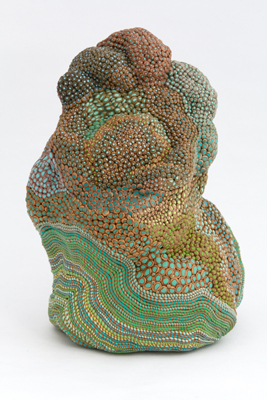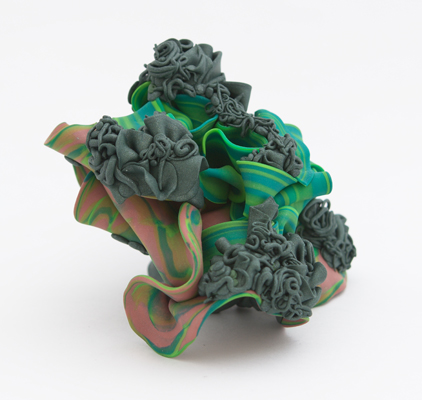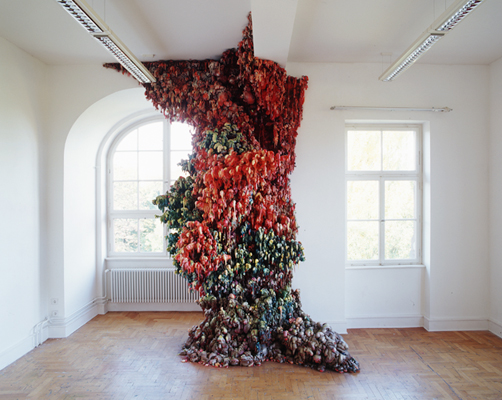 How does it feel to discover a compatriot – a fellow-traveler who has been a stranger up until this point – whose work speaks in similar thoughts as your own? After a friend sent me a link to the work of Angelika Arendt, I was a bit astounded by the similarities found between her sculpture and mine. We have been making sculpture in different countries (she lives and works in Germany), at different times (I am older than her), and with different influences. But yet, our two bodies of work echo one another in distinct ways. And so there are two of us, and presumably many more, who blend and form color in 3D, who accumulate blobs, dots and cross-sections to create many small hidden places, shaping compound curves into biomorphic structures.
How does it feel to discover a compatriot – a fellow-traveler who has been a stranger up until this point – whose work speaks in similar thoughts as your own? After a friend sent me a link to the work of Angelika Arendt, I was a bit astounded by the similarities found between her sculpture and mine. We have been making sculpture in different countries (she lives and works in Germany), at different times (I am older than her), and with different influences. But yet, our two bodies of work echo one another in distinct ways. And so there are two of us, and presumably many more, who blend and form color in 3D, who accumulate blobs, dots and cross-sections to create many small hidden places, shaping compound curves into biomorphic structures.
Frau, a recent piece from 2011, starts simply from a cylindrical base of coin-sized concentric circles of blue, olive and bronze, and then shifts upward to flowing stripes of colored dots in greens, blue-greens, browns and rust. After the soothing steady rhythms of its middle, the upper portion of the sculpture comes to a gentle crescendo. It is a vertical, but without the thrusting, imposing definitiveness of a tower or a totem. It looks as if it could support weight, but not like the static sturdiness of a pillar or a beam, but as a growing thing. The shapely undulations of its surface could hide muscle and bone, its strength derived from the their dynamic tension, their responsiveness to its particular shape and weight.
While one can easily imagine the sculpture’s growth originating from a mysterious force of nature, it is also satisfying to notice how obviously it is made by a human hand. We can imagine the artist rolling out coils of color, slicing, placing, molding, stretching, building up from bottom to top. It is this paradox of magic/mystery created by such a methodical, obvious and gimmick-free craft that makes the work so exciting.
 What I am drawn to most in her work is what happens to be least like mine. While starting from the same level of complexity, her work is unified with a holistic template and forms a composed beauty. Maybe this is the reward of having two perspectives on the same landscape: the two views multiply and increase their individual value. Viewers can feel the distinctions—can feel the difference between harmony and dissonance, viscerally, specifically, through contrast. And for the artist, as it is in my case, it leads to questions—why do I make sculptures this way rather than another? What is this tendency to make sculptures on the verge of aesthetically falling apart? Is it habit? Is it a false avant-gardism? Or is it a real, meaningful, necessary impulse? What if I tried something different, tried for more unity, instead of falling again for an easy dissonance? Of course there is no answer to these questions here. Such inquiries can only be worked out when absorbed into the work of the studio.
What I am drawn to most in her work is what happens to be least like mine. While starting from the same level of complexity, her work is unified with a holistic template and forms a composed beauty. Maybe this is the reward of having two perspectives on the same landscape: the two views multiply and increase their individual value. Viewers can feel the distinctions—can feel the difference between harmony and dissonance, viscerally, specifically, through contrast. And for the artist, as it is in my case, it leads to questions—why do I make sculptures this way rather than another? What is this tendency to make sculptures on the verge of aesthetically falling apart? Is it habit? Is it a false avant-gardism? Or is it a real, meaningful, necessary impulse? What if I tried something different, tried for more unity, instead of falling again for an easy dissonance? Of course there is no answer to these questions here. Such inquiries can only be worked out when absorbed into the work of the studio.
Even though Arendt remains a stranger to me, I like having the company, one that lives in another country but inhabits the same territory. It feels as if we are having a conversation that progresses at the pace of sculpture, slow with long gaps of silence between finished thoughts.
To see more of her work, visit her website.

This is so incredible, finding another artist with an aesthetic so close and yet not the same. I was looking at her website and noticed she was in a show this year called Biomorph at the Art Museum. My friend’s name is Julie Hayward. Also your writing about her work reveals the nature and significance of individual difference-while looking at amazing similarities.
Thanks, Nancy. Yes. I like that ‘so close yet not the same’ – those two things together are what makes it interesting.
View a list of artists in Biomorph